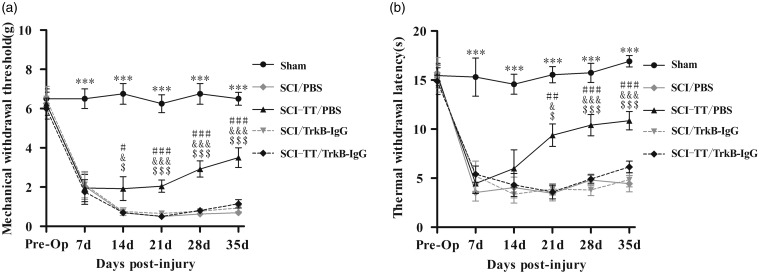Figure 2.
Effects of BWSTT on mechanical withdrawal thresholds (MWTs) and thermal withdrawal latencies (TWLs) in rats with or without blocking TrkB signaling. (a) Variation trend of MWTs of rats in each group at different time points. (b) Variation trend of TWLs of rats in each group at different time points. n = 8 rats per group. Statistical analysis used repeated measures ANOVA, and Tukey’s post hoc was then used to compare the values of the five groups of rats at the same time point. Compared with Sham group after 1 week of SCI, ***P < 0.001. SCI-TT/PBS group vs SCI/PBS group, #P < 0.05, ##P < 0.01, ###P < 0.001. SCI-TT/PBS group v.s. SCI/TrkB-IgG group, &P < 0.05, &&P < 0.001. SCI-TT/PBS group vs SCI-TT/TrkB-IgG group, $P < 0.05, $$P < 0.01, $$$P < 0.001. There was no significant difference in the MWTs and TWLs among the SCI/PBS group, the SCI/TrkB-IgG group, and the SCI-TT/TrkB-IgG group at each time point.
BWSTT: body weight-supported treadmill training; TT: treadmill training; SCI: spinal cord injury; PBS: phosphate-buffered saline; BDNF: brain-derived neurotrophic factor; TrkB: tropomyosin-related kinase B; Pro-Op: pre-operation.

